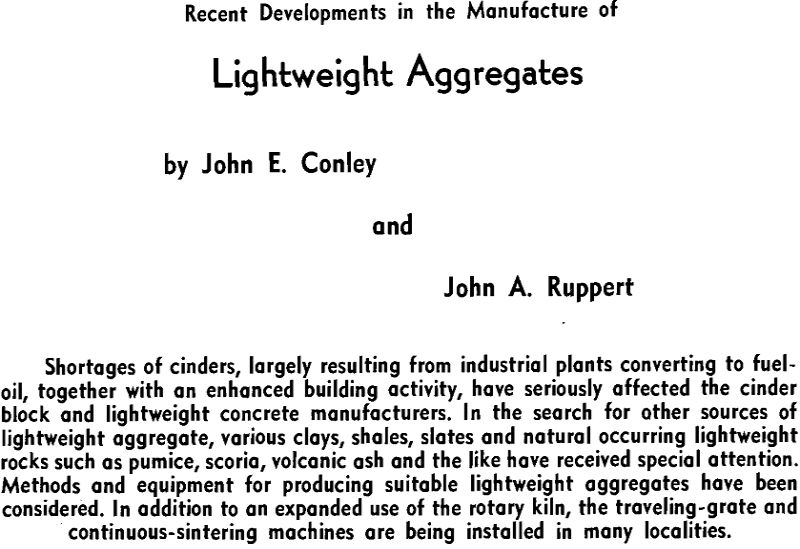Table of Contents
Lightweight aggregates have been in use for many years in the United States but are now receiving more and more attention by manufacturers and users of concrete shapes. These shapes comprise building blocks, special forms, such as door sills, lintels, floor slabs, and beams. Lightweight aggregate also is adapted for monolithic construction. The increased building activity since termination of the war, together with the widespread shortage of cinders resulting from a general trend toward the use of oil and pulverized-coal fuels, has aggravated the situation.
Structural Uses of Lightweight Aggregates
Production of masonry blocks in the United States has averaged close to a billion units a year for the past three years, and of these it is estimated that more than 40 pct consisted of the lightweight type. It is anticipated that the future will witness an increase in this percentage in view of the superior insulating properties, decrease in dead weight, and ease of handling, transporting, and laying units of this type.
Lightweight aggregates are used extensively in multi-storied buildings in which the weight of the walls and floors is carried by a structural steel framework. The substitution of a lightweight concrete for normal concrete in a building of this type has brought about in many instances some or all of the following advantages:
- A reduction in the amount of structural and reinforcing steel needed.
- Better heat and sound insulation in walls and floors.
- Lower costs for the construction of concrete forms.
Types of Aggregates
The aggregates finding commercial acceptance today in the United States might be roughly classified into two groups. The first comprises the extremely light materials, such as exfoliated vermiculite and expanded perlite, weighing 3 to 25 lb per cu ft and utilized in concretes where high-insulating characteristics are desirable. These materials usually yield concretes having 28-day compressive strengths in the range of 100 to 1000 psi. Because of their extreme bulk, aggregates of this nature seldom are transported long distances in their expanded forms but are shipped in the raw state and processed in the areas where they are consumed.
Aggregates of the second group include those weighing 30 to 70 lb per cu ft and capable of yielding concrete with 28-day compressive strengths of 1000 to 5000 psi or more in some instances. These medium- and high-strength aggregates might be further classified as to methods of manufacture as follows:
- Naturally occurring aggregates.
- Expanded or foamed slags.
- Bloated aggregates produced in rotary kilns.
a. Crushed to size after firing.
b. Crushed or extruded to approximate size before furnacing and then fired without agglomeration. - Sintered aggregates.
Methods for producing aggregates of both groups will be discussed briefly with particular emphasis on history and recent developments.
Vermiculite: Vermiculite is a hydrated magnesium aluminum silicate that possesses the extraordinary characteristic of expanding from 6 to 20 times its original volume upon being heated. In the United States, it is mined in Montana, Wyoming, Colorado, South Carolina, and North Carolina.
Perlite: A relative newcomer to the lightweight aggregate field, perlite is an acidic lava containing 2 to 5 pct water and is capable of expanding with disruptive violence 6 to 10 times its original size when subjected to rapid heating.
Naturally Occurring Aggregates
These include pumice, pumicite, volcanic ash, scoria, and diatomite. Pumice, the most widely used of these materials at present, is of volcanic origin and occurs only in the western regions of the United States. Considerable activity has taken place during the last three years, both in the development of new deposits and the study of techniques of mixing pumice concrete.6’7 Pumice is mined in California, New Mexico, Oregon, Utah, Idaho, and Washington. Some of the more progressive producers have set up screening as well as crushing equipment, so that the product can be shipped separately in two or more sizes. The consumer is thereby able to choose the proper ratio of coarse to fine aggregate for each batch of concrete. Ungraded crusher-run pumice has the disadvantage of tending to segregate during shipment so that there is a danger of successive batches of concrete being nonuniform.
Various schemes have been suggested to avoid processing troubles caused by the adhesive tendencies of bloating materials as well as to produce an aggregate consisting of discrete, well-rounded particles, each having a uniformly cellular interior sealed off by a hard impervious surface. Firing can be accomplished without causing the particles to agglomerate on their way through the kiln. Subsequent crushing thereby will be rendered unnecessary. Of these proposed methods, most have been abandoned because of high production costs.

A third variety of traveling-grate machine is being marketed in the United States by another manufacturer specializing in concrete-block machinery. Possible future installations may be at Denver, Colo., and Bridgeport, Conn. The prototype of this apparatus is in the New York City area where experimental work has been done with fly ash as a raw material. In appearance, the machine is similar to the Dwight-Lloyd circular-grate type sintering machine first patented in 1909 (U. S. Patent 916,392). The device consists of a series of hinged pans or grates disposed adjacently to one another in an annular configuration, rotatable about its axis. Beneath the grates is positioned a C-shaped suction box that draws combustion-supporting air through the material being sintered.


Related: 8 great lightweight folding hand trucks
